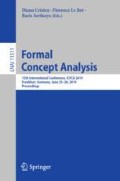Abstract
Formal Concept Analysis (FCA) provides a mathematical tool to analyze and discover concepts in Boolean datasets (i.e. Formal contexts). It does also provide a tool to analyze complex attributes by transforming them into Boolean ones (i.e. items) thanks to conceptual scaling. For instance, a numerical attribute whose values are \(\{1,2,3\}\) can be transformed to the set of items \(\{\le 1, \le 2, \le 3, \ge 3, \ge 2, \ge 1\}\) thanks to interordinal scaling. Such transformations allow us to use standard algorithms like Close-by-One (CbO) to look for concepts in complex datasets by leveraging a closure operator. However, these standard algorithms do not use the relationships between attributes to enumerate the concepts as for example the fact that \(\le 1\) implies \(\le 2\) and so on. For such, they can perform additional closure computations which substantially degrade their performance. We propose in this paper a generic algorithm, named CbOI for Close-by-One using Implications, to enumerate concepts in a formal context using the inherent implications between items provided as an input. We show that using the implications between items can reduce significantly the number of closure computations and hence the time effort spent to enumerate the whole set of concepts.
Access this chapter
Tax calculation will be finalised at checkout
Purchases are for personal use only
Notes
- 1.
Source Code. https://github.com/BelfodilAimene/CbOImplications.
- 2.
Delay time: maximum time between two outputs, between the beginning and the first output and between the last output and the ending of an enum. algo. (cf. [13]).
- 3.
EPD8 (last accessed on 04 Octobre 2018): http://parltrack.euwiki.org/.
- 4.
Yelp (last accessed on 25 April 2017): www.yelp.com/dataset/challenge.
- 5.
Bilkent repository: http://funapp.cs.bilkent.edu.tr/.
- 6.
UCI repository: https://archive.ics.uci.edu/ml/index.php.
References
Aho, A.V., Garey, M.R., Ullman, J.D.: The transitive reduction of a directed graph. SIAM J. Comput. 1(2), 131–137 (1972)
Belfodil, A., Cazalens, S., Lamarre, P., Plantevit, M.: Flash points: discovering exceptional pairwise behaviors in vote or rating data. In: Ceci, M., Hollmén, J., Todorovski, L., Vens, C., Džeroski, S. (eds.) ECML PKDD 2017. LNCS (LNAI), vol. 10535, pp. 442–458. Springer, Cham (2017). https://doi.org/10.1007/978-3-319-71246-8_27
Belfodil, A., Kuznetsov, S.O., Kaytoue, M.: Pattern setups and their completions. In: CLA, pp. 243–253 (2018)
Boley, M., Horváth, T., Poigné, A., Wrobel, S.: Listing closed sets of strongly accessible set systems with applications to data mining. Theor. Comput. Sci. 411(3), 691–700 (2010)
Bordat, J.P.: Calcul pratique du treillis de galois d’une correspondance. Mathématiques et Sciences humaines 96, 31–47 (1986)
Cellier, P., Ferré, S., Ridoux, O., Ducassé, M.: An algorithm to find frequent concepts of a formal context with taxonomy. In: CLA, pp. 226–231 (2006)
Dietrich, B.L.: Matroids and antimatroids-a survey. Discrete Math. 78(3), 223–237 (1989)
Ganter, B., Wille, R.: Formal Concept Analysis. Springer, Heidelberg (1999). https://doi.org/10.1007/978-3-642-59830-2
Ganter, B.: Two basic algorithms in concept analysis. Technical report, Technische Hoschule Darmstadt (1984)
Ganter, B., Kuznetsov, S.O.: Pattern structures and their projections. In: Delugach, H.S., Stumme, G. (eds.) ICCS-ConceptStruct 2001. LNCS (LNAI), vol. 2120, pp. 129–142. Springer, Heidelberg (2001). https://doi.org/10.1007/3-540-44583-8_10
Ganter, B., Wille, R.: Conceptual scaling. In: Roberts, F. (ed.) Applications of Combinatorics and Graph Theory to the Biological and Social Sciences, pp. 139–167. Springer, New York (1989). https://doi.org/10.1007/978-1-4684-6381-1_6
Gély, A.: A generic algorithm for generating closed sets of a binary relation. In: Ganter, B., Godin, R. (eds.) ICFCA 2005. LNCS (LNAI), vol. 3403, pp. 223–234. Springer, Heidelberg (2005). https://doi.org/10.1007/978-3-540-32262-7_15
Johnson, D.S., Papadimitriou, C.H., Yannakakis, M.: On generating all maximal independent sets. Inf. Process. Lett. 27(3), 119–123 (1988)
Kaytoue, M., Kuznetsov, S.O., Napoli, A.: Revisiting numerical pattern mining with formal concept analysis. In: IJCAI, pp. 1342–1347 (2011)
Korte, B., Lovász, L.: Mathematical structures underlying greedy algorithms. In: Gécseg, F. (ed.) FCT 1981. LNCS, vol. 117, pp. 205–209. Springer, Heidelberg (1981). https://doi.org/10.1007/3-540-10854-8_22
Krajca, P., Outrata, J., Vychodil, V.: Advances in algorithms based on CbO. In: CLA, pp. 325–337 (2010)
Kuznetsov, S.O.: A fast algorithm for computing all intersections of objects in a finite semi-lattice. Nauchno-Tekhnicheskaya Informatsiya ser. 2(1), 17–20 (1993)
Kuznetsov, S.O.: Learning of simple conceptual graphs from positive and negative examples. In: Żytkow, J.M., Rauch, J. (eds.) PKDD 1999. LNCS (LNAI), vol. 1704, pp. 384–391. Springer, Heidelberg (1999). https://doi.org/10.1007/978-3-540-48247-5_47
Kuznetsov, S.O.: Pattern structures for analyzing complex data. In: Sakai, H., Chakraborty, M.K., Hassanien, A.E., Ślęzak, D., Zhu, W. (eds.) RSFDGrC 2009. LNCS (LNAI), vol. 5908, pp. 33–44. Springer, Heidelberg (2009). https://doi.org/10.1007/978-3-642-10646-0_4
Le Gall, F.: Powers of tensors and fast matrix multiplication. In: Proceedings of the 39th International Symposium on Symbolic and Algebraic Computation, pp. 296–303. ACM (2014)
Lumpe, L., Schmidt, S.E.: Pattern structures and their morphisms. In: CLA, vol. 1466, pp. 171–179 (2015)
Roman, S.: Lattices and Ordered Sets. Springer, New York (2008). https://doi.org/10.1007/978-0-387-78901-9
Soulet, A., Rioult, F.: Efficiently depth-first minimal pattern mining. In: Tseng, V.S., Ho, T.B., Zhou, Z.-H., Chen, A.L.P., Kao, H.-Y. (eds.) PAKDD 2014. LNCS (LNAI), vol. 8443, pp. 28–39. Springer, Cham (2014). https://doi.org/10.1007/978-3-319-06608-0_3
Tarjan, R.E.: Depth-first search and linear graph algorithms. SIAM J. Comput. 1(2), 146–160 (1972)
Wille, R.: Restructuring lattice theory: an approach based on hierarchies of concepts. In: Rival, I. (ed.) Ordered Sets, vol. 83, pp. 445–470. Springer, Dordrecht (1982). https://doi.org/10.1007/978-94-009-7798-3_15
Aknowledgement
This work has been partially supported by the project ContentCheck ANR-15-CE23-0025 funded by the French National Research Agency, the ANRt French program and the APRC Conf Pap-CNRS project. The authors would like to thank the reviewers for their valuable remarks. They also warmly thank Anes Bendimerad for interesting discussions.
Author information
Authors and Affiliations
Corresponding authors
Editor information
Editors and Affiliations
Rights and permissions
Copyright information
© 2019 Springer Nature Switzerland AG
About this paper
Cite this paper
Belfodil, A., Belfodil, A., Kaytoue, M. (2019). Mining Formal Concepts Using Implications Between Items. In: Cristea, D., Le Ber, F., Sertkaya, B. (eds) Formal Concept Analysis. ICFCA 2019. Lecture Notes in Computer Science(), vol 11511. Springer, Cham. https://doi.org/10.1007/978-3-030-21462-3_12
Download citation
DOI: https://doi.org/10.1007/978-3-030-21462-3_12
Published:
Publisher Name: Springer, Cham
Print ISBN: 978-3-030-21461-6
Online ISBN: 978-3-030-21462-3
eBook Packages: Computer ScienceComputer Science (R0)

